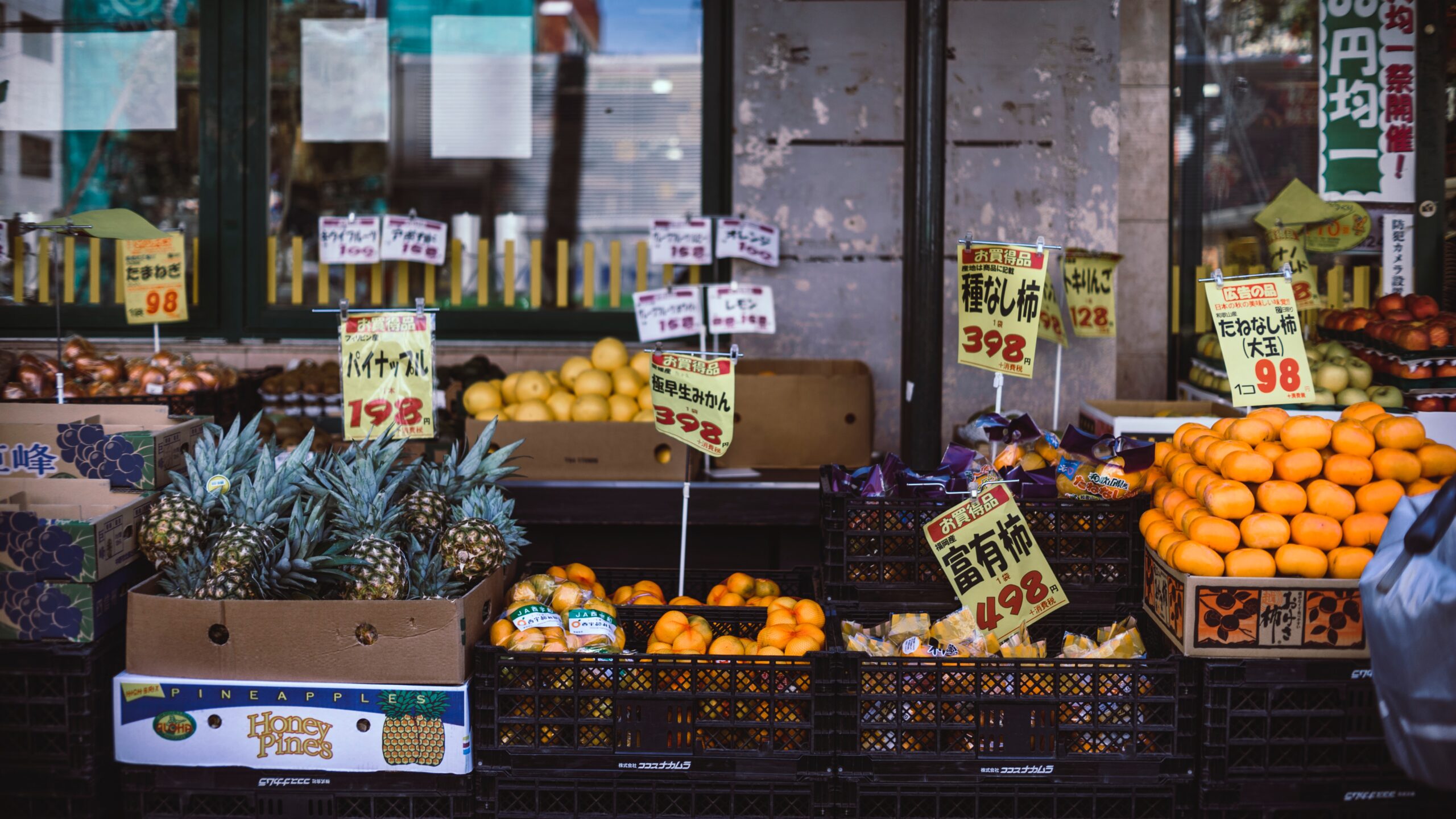
When you travel abroad, visiting grocery stores or supermarkets there is one of the most fun parts in the trip. There are a lot of unique food that is used for local dishes, good for souvenirs, and cheap enough to save food expenses. Grocery stores in Japan are one of them, and you should absolutely visit to buy some foods there to learn the real Japan.
For those who do not speak Japanese, it may be a bit hard to do shopping in Japanese grocery stores smoothly because everything is written in Japanese and most of store employees do not speak English. However actually, there are not any complicated systems to do it at all. This article should be helpful to enjoy your experience and take advantages of save money in your trip!
Several important facts you should know about Japanese grocery stores.
First of all, Japanese grocery stores have some important features that are different from many western countries.
1.Shopping cart & baskets are separated
In most of western countries, shopping carts in grocery stores are simply “baskets with wheels”, but in Japanese grocery stores, there are “baskets” and “shopping cart”. At the entrance, you can take only a basket, or with a shopping cart. Shopping carts are useful to carry heavy stuffs, but it is also a bit inconvenient to go through narrow aisles. So, the option of “using a basket without a shopping cart” is suitable when you must carry several stuffs but those are not heavy.
2.Cashers and self-packing tables are separated
In Japanese grocery stores, shopping bags cost extra, and you must pack what you bought by yourself as in a lot of western countries. One thing that is unique in Japan is something you see after you go through a casher, which are tables for packing what you bought. It is convenient that you can take your time to do packing in enough space there, do not need to rush at a casher. In addition, you can help yourself small plastic bags for free there…! These are so helpful to prevent your bag from getting wet with some leaking liquid from a pack of meat or fish.
3.Free microwaves, hot water and ice cubes are available
Usually near the self-packing tables, you can find some microwaves and electric hot water heating pots. Surprisingly, you can use them for free in grocery stores in Japan. These are no useful if you are so hungry that feel like to eat something hot soon after you get it. Moreover, there is often a freezer with ice cubes, and you can also help yourself. These free ice cubes are for keep what you bought cold: not for drinks, but so helpful to prevent food from going bad, and lovely ice creams from melting before you bring them back to where you stay in.
4.Some of them do not accept credit cards
While Japanese grocery stores have a lot of innovative features, there are also some negative aspects. One of them is about payment; some Japanese grocery stores do not accept credit cards. Generally, the rate of credit card usage in Japan is lower than a lot of western countries. Of course, it is mostly available in big grocery store chains, but there are still not a few stores that accept only cash, especially in countryside. Therefore, it is better for you to prepare some cash beforehand to avoid having troubles at a casher.
For SHORT-TERM travelers in Japan
If you stay in Japan just for a couple of weeks, you might prefer eating out to cooking by yourself. However, you should know that Japanese grocery stores also have a lot of food that suit to what short-term travelers need. You do not need to cook, but just need some hot water, microwave or refrigerator that are usually available at hotels. Here are some of recommendations below to get in Japanese grocery stores:
☆Ready-made food
In Japanese grocery stores, you can find a wide variety of food that is already cooked to eat, which are called “So-Zai”. For example, there are Japanese traditional fried chickens, tempuras, salads, sushi, and even healthy packed lunches…! It is great opportunity for you to enjoy Japanese homely taste with so cheap price. Moreover, if you go to a grocery store in the evening, you can often see these ready-made foods are discounted. You should not lose that opportunity to enjoy these with as cheap price as possible.
☆Bread / Rice ball
You would be surprised to see many kinds of bread and rice ball in Japanese grocery stores. When it comes to breads, there are not only typical white breads for sandwiches and buns for hamburgers, but also many unique ones that are wrapped separately. Some of them are sweet, some others are spicy, salty, or plain, so you can choose ones that suit to any meals in anytime as you like. Also, you can find a lot of rice balls, called “Onigiri”. Usually, it is shaped triangle, covered with seaweed called “Nori”, and have many different fillings in it. You would be surprised to see its convenience to bring and eat anywhere and good taste even without heating.
☆Cup noodles
In these days, ramen is one of the most popular Japanese foods in the world besides sushi. Cup noodles, which are called “Cup ramen” in Japan, are incredible invention from Japan to enjoy ramens so easily: just pouring hot water in a cup and waiting for 3~4 minutes. Even though you can find some cup noodles in other countries as well, Japanese grocery stores have the largest selection of them, so you can try many different ones and find your favorite.
☆Snack / Sweets
Even though eating snacks and sweets is not healthy diet, everyone often needs them.
One of the most popular Japanese traditional snacks that are available in every grocery store is called “Senbei”, which is a kind of rice crackers and usually flavored with soy sauce or salt. There are also some sweets with red beans paste for Japanese typical snack time. These Japanese traditional snacks do not contain so much oil, eggs and milk that are less fatty than a lot of western ones. However, of course you can find a lot of candies, cookies, and chips as well. It would be also interesting for you to compare western snacks and sweets in Japan to ones in your country. You should not forget to bring some of them to your home as souvenir…!
For LONG-TERM travelers in Japan
For those who stay or live in Japan for more than weeks or months, grocery stores are necessary to save your food expenses as much as possible. Of course, you can try cooking some Japanese food, but also there are ingredients for a lot of kind of dishes from all over the world, so you can cook whatever you want, even your home dishes. Here are some features you should know about Japanese grocery stores when you try to get typical ingredients there to cook:
☆Vegetable / Fruit
In Japanese grocery stores, you can see a lot of vegetables and fruits that are common in western countries, such as tomatoes, potatoes, onions, and carrots. In terms of their price, one of the clearest tendencies are that domestic ones are more expensive than imported ones. There are a lot of vegetables and fruits that are imported from China or other Asian countries, but ones made in Japan are known as having good quality and tend to cost more. Especially Japanese fruits are so expensive. For example, just an apple an orange usually costs over $1 for each. To get them with a good deal, it is better to choose ones sold in bulk.
☆Meat / Fish
The best 3 popular kinds of meat in the world: pork, chicken, and beef, are in every grocery store in Japan. On the other hand, you can only find meats of lamb and turkey sometimes, and rarely find meat of rabbit. However, there is something much more remarkable than meat: fish. Japan is the country of sushi, so grocery stores have a wide variety of fish and other seafoods with cheap price. If you would like to try sashimi (raw fish), you must choose ones that are safe to eat uncooked. You can find them with the word “刺身” on a package, or you can ask a store employee. (You can use the phrase in the following section.)
☆Rice / Pasta
The Japanese traditional staple food is rice, so there is a big section of rice in every grocery store in Japan. There is a ton of different brands of rice from different parts, so you can enjoy comparing the tastes of them. If you care about your health so much, you can also choose brown rice that contains a lot of dietary fiber and vitamins. However, because many Japanese people also like pasta, you would find much more kinds of it than you expect. The ingredients of popular pasta sauce in Western countries, such as one for Bolognese, Carbonara and Amatriciana are easily available there as well, so you can enjoy your favorite pasta even if you are not a big fan of Japanese food.
☆Seasoning
There are a lot of Japanese traditional seasonings in Japanese grocery stores. For example, you can find a wide variety of soy sauce as one of the popular ones in the world, “Dashi” and “Miso”. These Japanese seasonings are necessary when you try to cook Japanese food with subtle and delicate flavor. In addition, a lot of western seasonings, such as ketchup, mayonnaise and yellow mustard are also common in Japan, so you would not worry about the lack of seasonings for whatever you cook.
When you need to talk to store employees…
Even if you went to Japanese grocery stores with a lot of knowledges about it, it would be possible for you to have some troubles. Therefore, you should learn some Japanese phrases to ask something you need.
・Excuse me.
→ “SUMIMASEN”(すみません)
・Do you have ~ ?
→ “~ WA ARIMASUKA?” (~はありますか?)
・Can I eat this (fish) raw?
→”KORE WA SASHIMI DE TABERAREMASUKA?” (これはさしみでたべられますか?)
・Can I get a plastic bag?
→ “FUKURO WO KUDASAI” (ふくろをください)
・Can I use a credit card?
→ “KAADO WA TSUKAEMASUKA?” (カードはつかえますか?)
・How much is it?
→ “IKURA DESUKA?” (いくらですか?)
・Thank you.
→ “ARIGATO GOZAIMASU” (ありがとうございます)
Conclusion
In short, grocery stores in Japan are fantastic for all travelers!
Even if you do not speak Japanese, you can get used to its simple and convenient systems and realize that how interesting to see some food that are unique in Japan and common with your home there. Eating habit is a big part of culture, so by visiting grocery stores in Japan, you can learn one of the bases of Japanese living and deepen your understanding about Japanese culture.
Japan has a ton of beautiful places to visit, and you can find grocery stores in every part. So, you should take advantages of them whenever you are and enjoy learning other aspects of Japanese culture! Remember that, Japanese people always welcome you!


